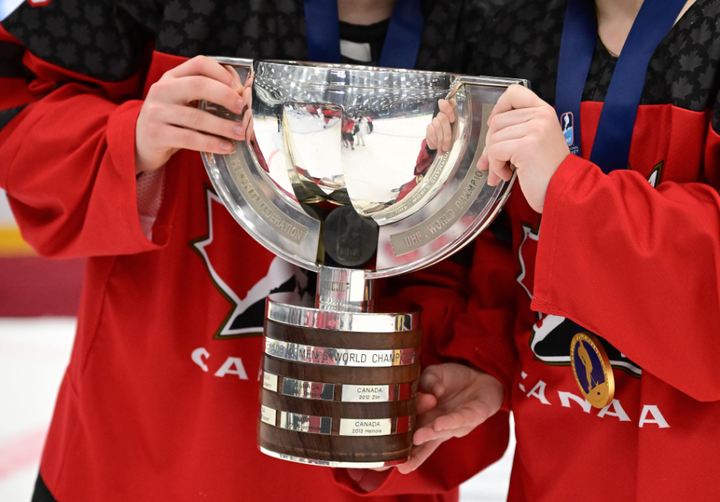Women's sledge hockey players are taking their game to the next level
The U.S. and Canadian women's sledge hockey teams are at the top of their sport, but they're doing it without resources from USA Hockey and Hockey Canada
A dominant force in women’s sledge hockey since her early teens, American Kelsey DiClaudio is breaking barriers in the sport ― though she hasn’t got a lot of options otherwise. The 19-year-old has a chance at being the first woman to play sledge hockey at the Paralympic Games, but she’d be happy to have a full team of women by her side.
In the absence of a women's tournament, international sledge hockey was transformed from a men’s-only discipline to co-ed prior to the 2010 Paralympics. At the highest levels of the sport, though, this change has been more in name than in practice. No woman has ever competed in sledge hockey at the Games, and only a handful have competed in co-ed International Paralympic Committee (IPC) sanctioned events.
Two years ago, DiClaudio made the U.S. National Development Team, becoming the first woman in North America to play for a federation-funded sledge team. Now in her third year with the program, the forward has proven herself to be a versatile and reliable two-way player ― so much so that in the absence of two regular defensemen, her coaches slotted her at defense in a three-game series against the Canadian development team at the 2017 Défi sportif AlterGo.
“I’ve been offense my entire life ― 10 years I’ve played, I’ve been very offensive-minded,” she explained. “It was a huge adjustment, but they’re teaching me well. They’re telling me what I’m doing wrong, they’re telling me what I’m doing well, and I keep building off of that every game. And it’s good to know every position as a player.”
Despite having no prior experience on the blueline, DiClaudio helped Team USA to three consecutive shutouts, with a combined score of 16-0.
“[The coaches] put me out there and they felt confident in me, and that can go a long way,” she added.
Before making the development squad, DiClaudio was selected to the U.S. Women’s Sled Hockey Team at just 13 years old. Unlike men’s sledge hockey, which has been fully integrated into the Hockey Canada and USA Hockey structures, the women’s national teams currently exist outside of the federations. In her five seasons, DiClaudio has witnessed the growth of the women’s program, but the lack of institutional support limits both the amount of time the women’s national team can spend together and the resources available to its players.
“It’s so different,” she said of her experience with the development team compared to the women’s team. “It’s so different. I see both sides of it ― a lot of people don’t see both sides. I see the women’s side and the men’s side and I see what the men get, I see what they’re funded, and they’re so spoiled! I get back to the women’s side and I’m like, ‘oh my god.’ Honestly, they take things for granted over here and I’m like, ‘c’mon guys!’
“They get all these snacks and all this chocolate milk and all this everything,” she laughed. “We just got a trainer. We don’t even have an equipment guy or anything like that. So it’s kind of ‘just get out there and play’ with the women’s team. You put on your jersey, represent your country, and get out there and play. You’re just playing for the love of the game, basically. That’s basically what it is. All we need is to get under the umbrella of USA Hockey.”
DiClaudio aims to compete in the Paralympics, and as one of the best players in the sport, she has a real chance of achieving that with the senior team, whether in 2018 or 2022. But although she might be one of the few women capable of cracking an ostensibly-co-ed men’s national team roster, she’s committed to developing the women’s game and fighting for women’s sledge hockey to garner the recognition it deserves.
Without federation funding, players on the women’s side are often forced to pay their own way in order to participate in the national team program. There are no training stipends available, and with fewer resources than their counterparts on the men’s team, players take on an added responsibility in their own development. DiClaudio trains off-ice four times a week and practices on-ice with her club team once weekly. She balances this with two sets of national team duties, club tournaments, and full-time college studies, all without access to the financial support systems that many elite athletes rely on.
Despite USA Hockey and Hockey Canada’s lack of involvement in the women’s programs, the two national teams are well ahead of the rest of the world. Players hope to narrow that gap so that their sport can become more competitive, but developing the game abroad can prove difficult when the American and Canadian programs are themselves underfunded. Being integrated into their respective federations would remove the burden of travel costs, accommodations, and tournament entry fees, enabling Canada and the U.S. to take a more active role in growing the sport internationally.
“It’s all about growth and development at this point,” DiClaudio explained. “There aren’t a lot of females in sled hockey. There aren’t a lot of females in hockey in general, especially around the world. The U.S. and Canada are really the only powerhouses of sled hockey right now, so just getting it out in the rest of the world and just getting the girls out there to play, that’s all we need to get to the Paralympics.”
“We want to travel internationally and we want to get to the Paralympics, but it’s so hard when not everyone works with you.”
The IPC sanctioned the inaugural Ice Sledge Hockey International Women's Cup in 2014, hosted in Brampton, Ont., and featuring three teams. International tournaments thus far have included Team Canada, Team USA, and a combined Team Europe, which consists of players from European countries that can’t yet field a competitive national team. Even then, the U.S. and Canada generally emerge victorious, though games are getting tighter.
In order for women’s sledge hockey to become a Paralympic sport, there is a minimum number of countries that must sponsor an entry ― likely four or six. Current and past members of Team Europe have represented four countries, suggesting that with federation support, the foundation is there. But the present lack of involvement from the governing bodies means that for players who are already largely responsible for their own development, the prospect of achieving their dreams requires that they also take on the responsibility of growing the game in order to make those dreams possible.
Until the federations adopt the women's teams and until the discipline is added to the Games, making the women's national team is just the first step in the process. Fourteen-year-old Raphaëlle Tousignant is the youngest member of the Canadian women’s sledge hockey team. A natural athlete, she’s excelled after just a few years in the sport and is well on track to make it to the Paralympics ― as soon as her team does. In anticipation of the women’s game being added to the event, she’s hopeful that Hockey Canada will integrate the team within the next few years. The women’s program is regularly in touch with Marshall Starkman, the manager of Hockey Canada’s National Sledge Team, and is on the organization’s radar.
“At all of our training camps, Janice Coulter, who’s the president of the women’s team, updates us on the situation with regards to Hockey Canada,” noted Tousignant, adding that she believes it’ll happen sooner rather than later.
In the meantime, however, the women are left with minimal direct support from the federation. Whereas players in Hockey Canada programs can expect a level of funding that decreases their personal costs once they reach the senior national team, the price burden only increases for women’s sledge hockey players. From international competitions, to camps across Canada that are designed both to train the team and to expand the sport’s reach, participation is almost entirely self-funded. Add to that equipment costs and an upgrade to her sledge, and Tousignant spent about $8,000 in just her first season with the national team.
While Hockey Canada is in discussions with the Canadian women’s sledge team, USA Hockey is taking a somewhat more direct ― albeit still gradual ― approach to integrating the U.S. women’s team. This season, the governing body hosted a joint camp with the women’s program and the development team. Though the women’s team traveled on its own budget, its participation in the camp itself was funded by USA Hockey.
“They’re trying to make it more co-ed,” said DiClaudio, who attended with the development team. “It’s always good just to grow the game and give the girls a bit of experience as to what they need to be at to play at such a high level.
“Once they got there, the D-team took care of them. They were given snacks and stuff like that! They weren’t used to it ― they were in the locker room and they weren’t used to it at all, and I was like ‘yeah guys, isn’t this nice?’ But they got a little bit of a taste of it and they liked it a lot, and [the development program] took really good care of us.”
As a member of both teams, DiClaudio shifts between using ‘us’ and ‘them’ to refer to both the development squad and the women’s side. It’s not yet clear whether, once women’s sledge hockey is added to the Paralympic program, the co-ed tournament will revert to being men’s only, or if DiClaudio will have to make a choice. Even if she has to forge her own path twice over, breaking barriers in two different disciplines, it seems certain that she’ll reach the Games.
“When I started I wasn’t even looking for any adaptive sports or anything like that,” she reflected. “I went out and they gave me a sled. I was eight years old and I tried it and I just ― I fell in love with it. I just kept coming back for the weekly practices after that. I was invited to a couple of the D camps, and from there I just kept playing and listened to my coaches and kept working out.”





Comments ()